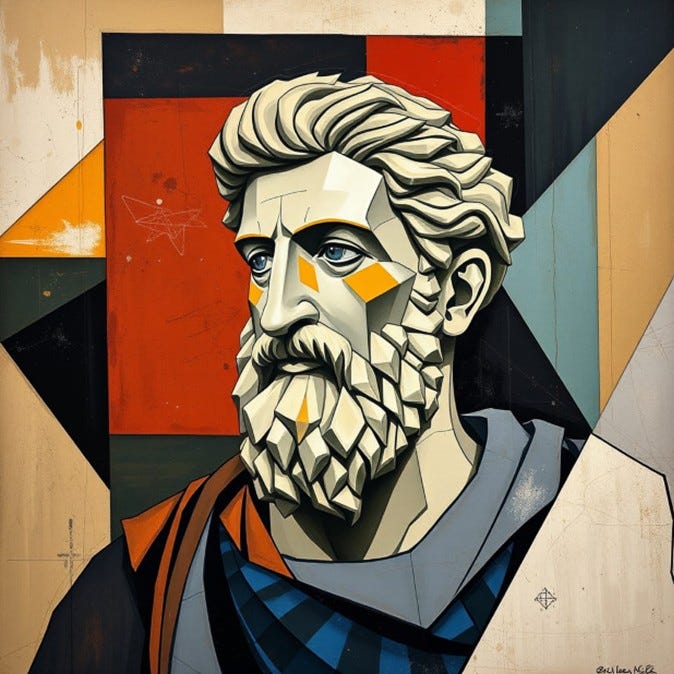Recently, my wife Banu asked me, “What would you say is the perfect design for your life?” I paused, then replied, “to bring beauty into the world.” I said something about art and the beauty of writing, the beauty of words.
Banu commented on the creative power of God’s word. We ourselves—who co-create with God—must be careful about the words we speak into the air, into the ether. She said, “Without the word, we do not exist.” I added, “Without logos, we do not exist.”
The philosophical and theological concept of logos (λογος) has been on my mind for several weeks. It was reintroduced to me as I read Marcus Aurelius’ Meditations (Gregory Hays’ translation).
[Marcus Aurelius, 121-180]
Marcus Aurelius, deeply influenced by Stoicism—a philosophy emphasizing reason, ethics, and alignment with nature—personified the ideal of a philosopher-king. He is considered one of the “good” Roman emperors. Stoicism, which arose in the 4th century BC, gradually declined as Christianity spread but still resonates today.
Thanks to Marcus, I’m even dipping my toe into Stoic thought.
In the introduction to the Meditations, Gregory Hays says, “Of the doctrines central to the Stoic worldview, perhaps the most important is the unwavering conviction that the world is organized in a rational and coherent way. More specifically, it is controlled and directed by an all-pervading force that the Stoics designated by the term logos. The term (from which English ‘logic’ and the suffix ‘-logy’ derive) has a semantic range so broad as to be almost untranslatable.” (xx) The Stoics inherited the idea from earlier schools of Greek thought.
Here’s just a taste of that “semantic range”: besides the primary definition “word,” logos means “declaration,” “discourse,” or “doctrine.” It means “account” or “cause.”
In his Meditations, Marcus notes several nuances of logos. Here are a couple of cases:
“Nature is pliable, obedient. And the logos that governs it has no reason to do evil. It knows no evil, does none, and causes harm to nothing. It dictates all beginnings and all endings.” (6.1) “To follow the logos in all things is to be relaxed and energetic, joyful and serious at once.” (10.12a)
It has a somewhat mystical feel, embracing opposites.
“As you move forward in the logos, people will stand in your way. They can’t keep you from doing what’s healthy; don’t let them stop you from putting up with them either. Take care on both counts. Not just sound judgments, solid actions—tolerance as well, for those who try to obstruct us or give us trouble in other ways.” (11.9)
Logos is a reasoning, creative power.
It is also fundamentally entwined with beauty. Phillip Suire, professor at the University of Louisiana, observes, “The connection between Logos and beauty is a fascinating and profound one, resonating with the idea that there exists an aesthetic dimension to the universe’s underlying order and wisdom.” Grandeur is built into the very fabric of space and time.
On that note, there is a story which comes to mind.
Back in the 90s when I was at seminary in Philadelphia, one of my favorite activities was going for long walks, especially in the evening. But if we had a decent amount of snowfall the previous night, I might decide to change my routine and go out in the morning. It was on one such morning that I ventured out into a landscape glistening with ice and snow. The whole world had been frosted with layers of confectioner’s sugar!
[This is not Philadelphia!]
As I relished the brisk chilly air, I encountered one of the elderly ladies from the Presbyterian Church across the street from our school. I often sat in one of the pews in “her” part of the sanctuary. I greeted her, and she acknowledged me, but not in the way one ordinarily does.
As she took in all that her senses were telling her about this magnificent morning, she seemed to be almost mesmerized, almost in a state of rapture. On that snowy sidewalk in Philly, all she said was, “There is so much beauty.” There is so much beauty, majesty beyond measure.
It was as though some celestial being had parted a veil and revealed some secret splendor. The look on her face—that moment—that’s what I remember about her.
The logos of Stoicism never quite reaches the status of proper noun. In the prologue to his gospel, John proclaims, “In the beginning was the Word, and the Word was with God, and the Word was God” (1:1). It is not the word, rather it is the Word. It is not the logos, rather it is the Logos. John joins the centuries of evolving elucidation and in grand fashion declares, “The Word became flesh and lived among us, and we have seen his glory, the glory as of a father’s only son, full of grace and truth” (v. 14). The Logos of the cosmos has emerged—has become matter—in the person of Jesus.
The beauty infusing all, every cosmic bit blinking in and out of reality, has been located in the Messiah, the source of life and light. However, that brilliance is not without attempts to mar its luster. Consequently, John states, “The light shines in the darkness, and the darkness did not overtake it” (v. 5). The word translated as “overtake” comes from the Greek καταλαμβάνω (katalambanō). It has several connotations, among them: “to obtain,” “to seize,” “to detect,” “to comprehend.”
The darkness just can’t handle the light! It tries to figure it out, but the darkness is simply clueless. Clueless and ignorant as it is, the darkness lashes out in frustration. It utters curses, not blessings.
The darkness is rendered powerless when the light of the Risen One shines forth.
And so, whether in the snow-laced silence of a Philadelphia morning or in the meditations of an emperor long gone, I return to that simple answer I gave my wife: to bring beauty into the world. I need all the “grace and truth” the Lord provides!
The beauty to be brought isn’t just aesthetic—but rooted in reason, spirit, and the Word that was in the beginning. In every syllable of creation, and in every silence that follows, the Logos still lingers—and the beauty is not yet finished.






